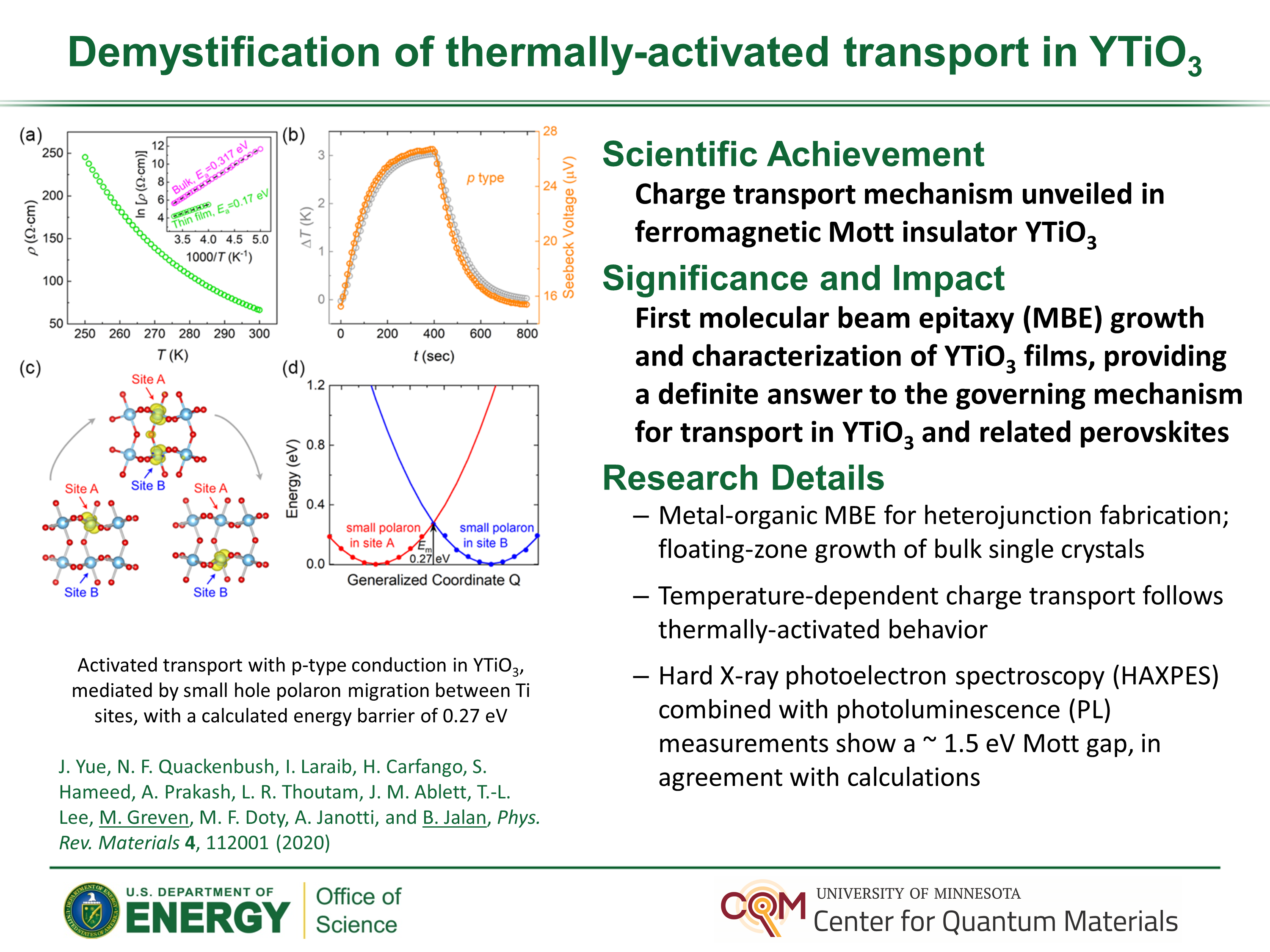
UMN Center for Quantum Materials scientists demonstrated the first molecular beam epitaxy (MBE) growth of YTiO3 films. Through a combined study of thin films and floating-zone grown bulk single crystals, a thermally-activated conduction mechanism involving positively charged carriers was revealed. Together with scientists at the University of Delaware, a combined theoretical and experimental investigation of the electronic structure and charge transport properties provided a definite answer to the governing mechanism for conduction in YTiO3 and related materials. The team has demonstrated that the charge transport in YTiO3 (a ferromagnetic Mott insulator) is due to small hole polaron migration and that the Mott-Hubbard gap of YTiO3 is ~ 1.5 eV.
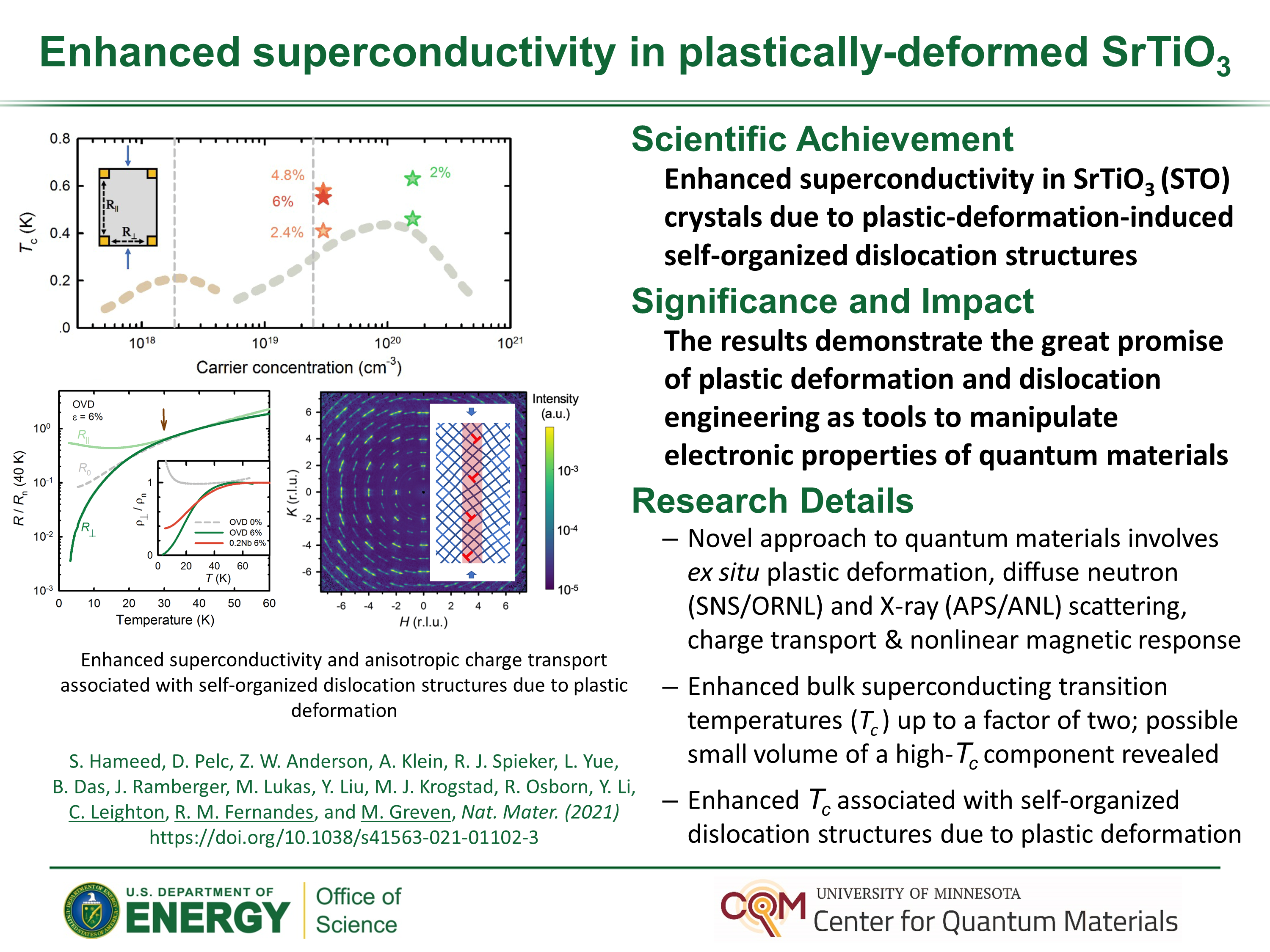
Superconductivity is a macroscopic phenomenon characterized by zero electrical resistance and complete expulsion of magnetic fields below a certain temperature, the superconducting transition temperature Tc. Superconductivity involves the formation of so-called Cooper pairs of electrons within a crystal, which often is mediated by the quantized vibrations of the atoms (phonons). In conventional theories of superconductivity, the phonon frequency of needs to be very slow compared to the electron motion. SrTiO3 is a system in which this condition is violated: the characteristic frequency of phonon vibrations is comparable to that of the electron motion, but the system still exhibits superconductivity, which has been a puzzle for more than five decades.
The application of reversible, elastic uniaxial strain has recently emerged as a powerful means to study and manipulate quantum materials. The effects of uniaxial stress beyond the elastic regime, however, are not widely studied in single-crystalline materials, with notable exceptions in the field of geophysics. The resultant plastic deformation fundamentally differs from elastic strain, as it creates extended defects – dislocations – and induces their self-organization into structures spanning many length scales. The local atomic arrangement near dislocation cores is very different from bulk, significantly modifying nearby electronic properties. Such effects are expected to be amplified when dislocations assemble into larger structures.
In this work, a team of scientists from the University of Minnesota Center for Quantum Materials, in collaboration with scientists at Argonne National Laboratory (ANL) and Oak Ridge National Laboratory (ORNL), uncovered inhomogeneously-enhanced superconductivity in plastically-deformed SrTiO3 crystals, with superconducting transition temperatures significantly greater than for undeformed samples. Through an extensive collaboration between theoretical and experimental scientists within the center, this enhanced superconductivity was found to be associated with self-organized dislocation structures formed as a result of plastic deformation, which decreases some of the phonon frequencies locally, and hence favors superconductivity. The study demonstrates the promise of plastic deformation as a tool to manipulate quantum materials to obtain exciting electronic properties.
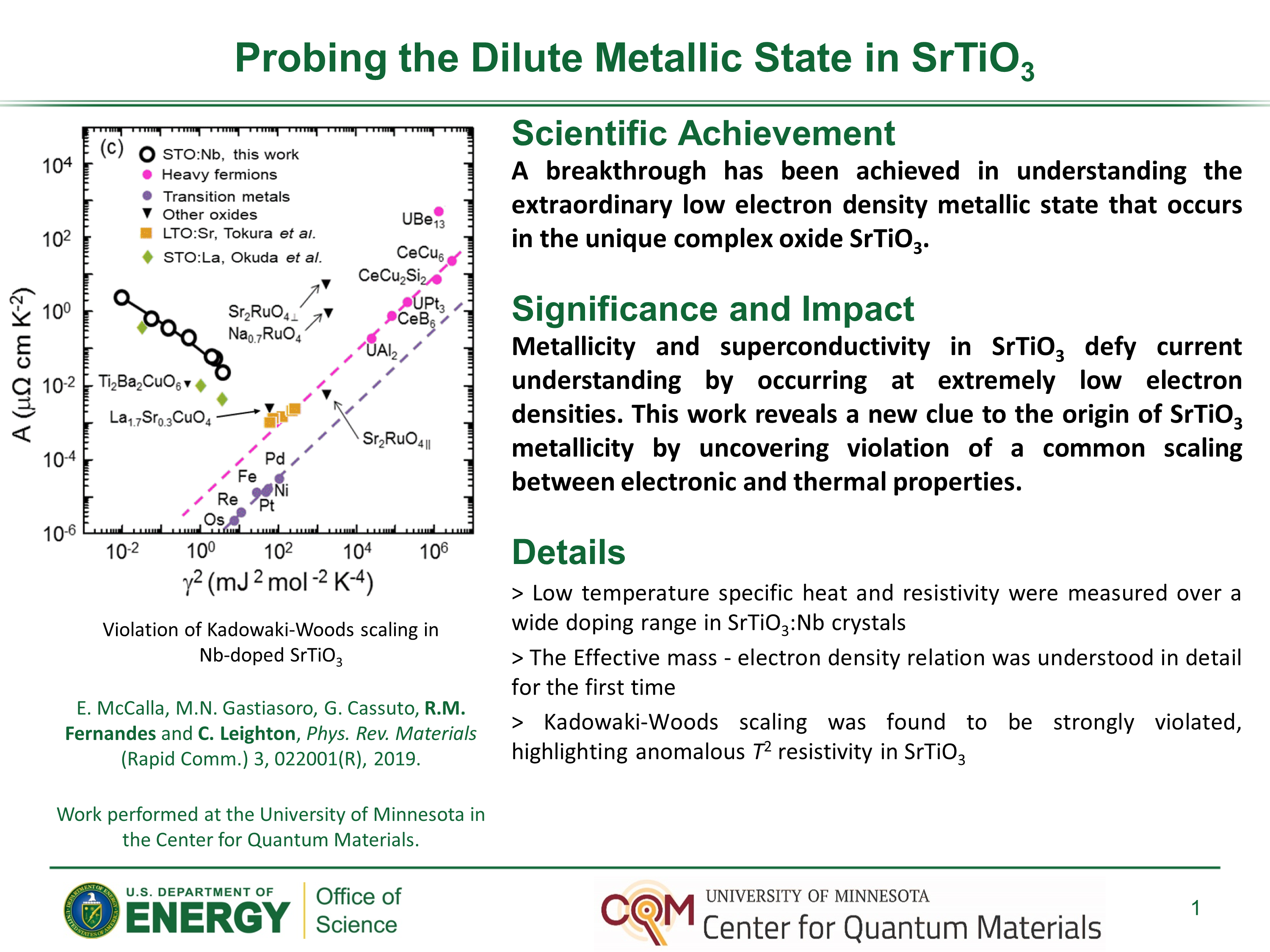
This work reported on the first detailed, systematic study of low temperature electronic specific heat in doped SrTiO3. This was done over a wide doping range, in Nb-doped single crystals. The electronic specific heat was shown to be typical of a Fermi liquid, using both experimental and theoretical approaches. The density-of-states effective mass extracted from the data were also shown to be quantitatively consistent with quantum transport data, revealing an increase to as high as 5 free electron masses with filling. Critically, this was shown to be reconcilable with theoretical band structure, revealing a notably filling-independent mass enhancement factor. Moreover, with a complete data set on both electronic specific heat and resistivity available for the first time, Kadowaki-Woods scaling between the T2 resistivity pre-factor (A) and the electronic specific heat (g) was tested. Massive, even qualitative, violations of the behavior expected for Fermi liquids was found (see Figure), highlighting the highly unusual nature of the T2 resistivity in SrTiO3. Whether this T2 resistivity even reflects Fermi liquid behavior in this material remains a major open question. This work will no doubt stimulate further work in this important direction.
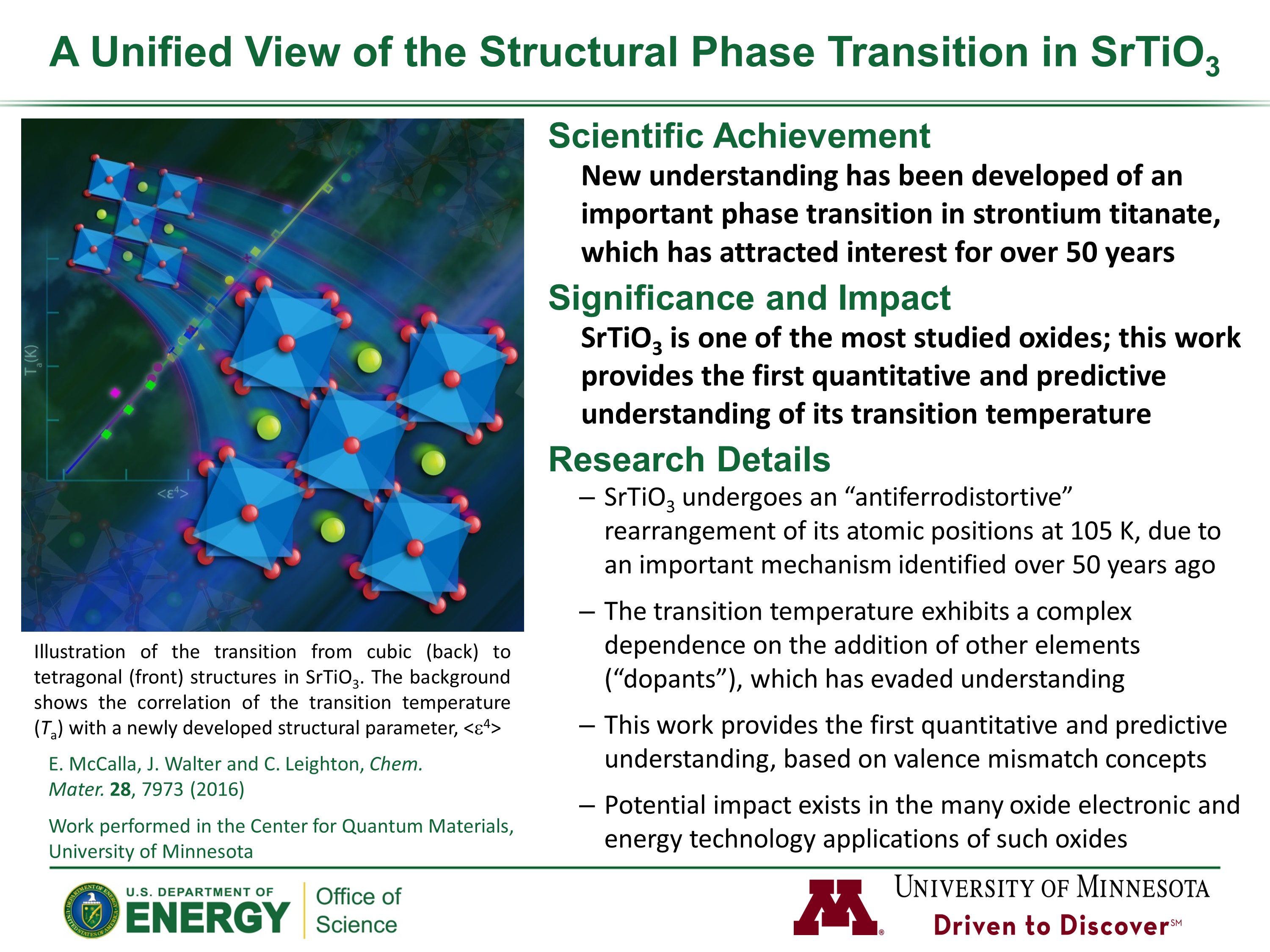
Strontium titanate, or SrTiO3, is the most widely studied perovskite oxide, a family of materials of vital importance in basic science and energy technologies. It was discovered over 50 years ago that SrTiO3 undergoes a phase transition at 105 K, where the Ti-O octahedra that make up its structure rotate in an alternating pattern. This is called an “antiferrodistortive” transition. What is so important about this structural change in SrTiO3 is that it has become a model for similar transitions in a large number of compounds, occurring via a mechanism known as mode softening. Although this mechanism has been understood for some time, some aspects of the transition remain mysterious. One example is that the transition temperature shifts from 105 K when different elements are substituted into SrTiO3. This shift can be downwards (to 0 Kelvin) or upwards, to above room temperature, the trends being very difficult to understand. In this work these trends have been understood for the first time, providing substantially deepened understanding. The key concept is the strain introduced by the foreign ion, more specifically the “charge strain” or “valence mismatch”. The authors combined new experimental data with a model based on bond valence sum calculations to establish a new parameter that controls, and can be used to predict, the transition temperature, providing new insight into an over 50 year old problem.

Superconductivity – the quantum state in which a metal loses all electrical resistance and exhibits magnetic flux expulsion (the Meissner-Ochsenfeld effect) – is one of the major research topics in condensed matter physics. However, in many important materials, superconductivity is not understood. Complex oxides are particularly interesting in this regard because of the wide temperature and composition ranges where superconductivity occurs, and because the origin of superconductivity is thought to differ for different oxide families. Here a team of scientists at University of Minnesota’s Center for Quantum Materials uncovered a remarkable universal feature shared by these distinct materials. The discovery was enabled by the development of a novel nonlinear magnetic response technique, an extremely sensitive probe of magnetism. The team found in experiments on three prominent classes of unconventional oxide superconductors – strontium titanate (STO), strontium ruthenate (SRO), and the cuprates (LSCO and Hg1201) – that upon cooling toward the macroscopic transition temperature Tc superconductivity emerges in a highly similar fashion (see Figure), despite dramatically different electronic properties and Tc values. Furthermore, the universal response follows highly unconventional, yet remarkably simple exponential behavior. It was also shown that this behavior above Tc can be influenced by intentionally inducing structural inhomogeneity into the materials via plastic deformation. This suggests that the origin of the universal behavior is related to intrinsic structural inhomogeneity, which is therefore an essential ingredient in the unconventional physics of all the studied systems.
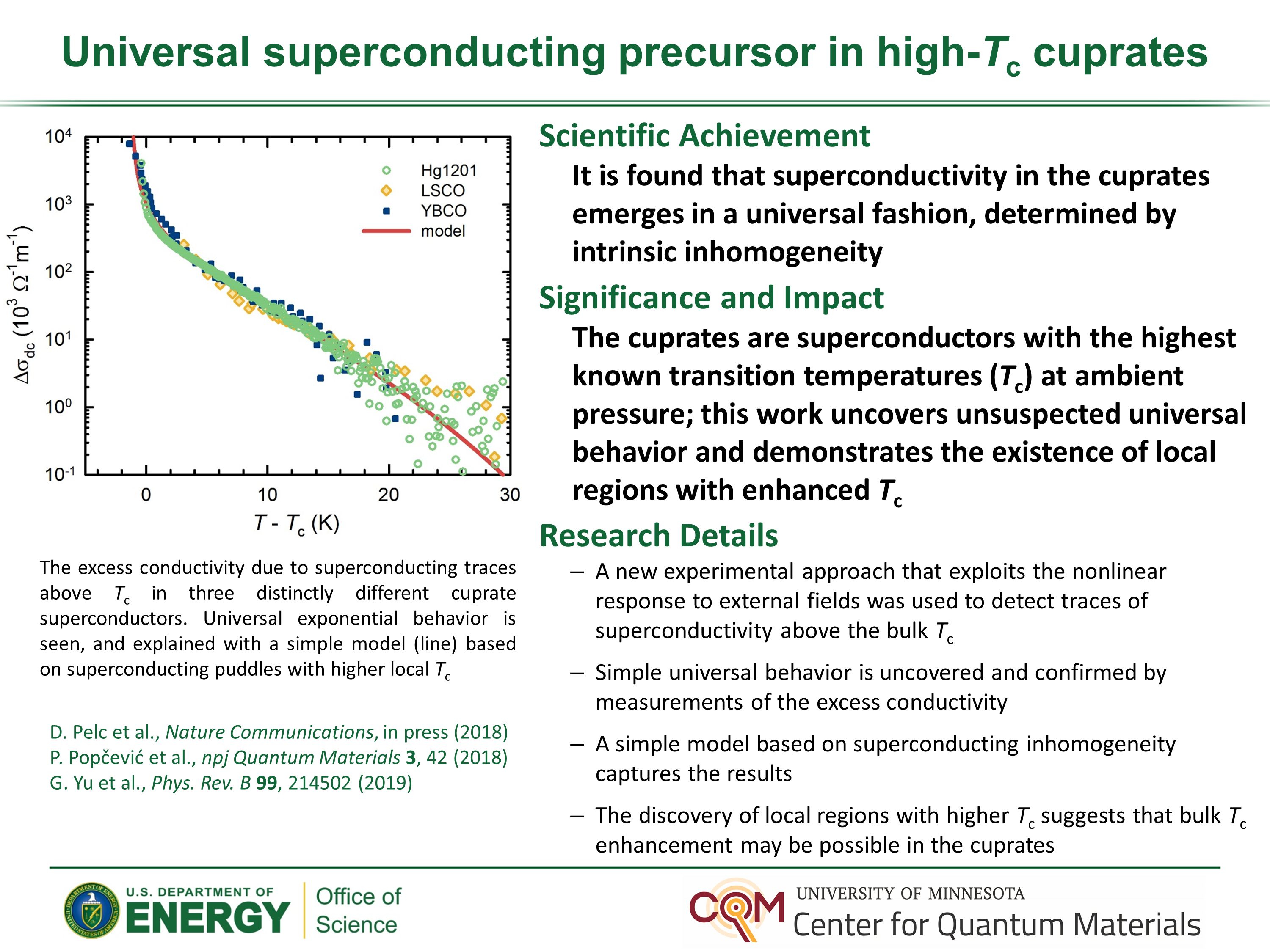
Many complex compounds that contain oxygen and copper – known as cuprates – become superconducting at temperatures much higher than most other materials. It is still not understood why this is the case and if these compounds can be tweaked to further increase the superconducting transition temperatures. In this respect, an outstanding open question is the nature of the superconducting precursor regime at temperatures above the bulk transition. In this regime, the materials are not fully-developed superconductors, but traces of superconductivity are still observable. Over the years, many experimental probes have been applied and theoretical ideas developed to study the precursor regime, but even basic questions – such as how far the regime extends above the bulk transition temperature – have remained unsettled.
In order to address these long-standing issues, a team of scientists from the University of Minnesota, Vienna University of Technology, Austria, and University of Zagreb, Croatia, developed a new approaches to detect the elusive superconducting precursor. They employ the fact that superconductivity is easily influenced by an external magnetic or electric field, and measured the resulting nontrivial response with several distinct experimental setups in a number of representative cuprates. The team discovered unsuspected universal behavior of the precursor that is at odds with conventional theory. However, the observations are explained within a simple model that invokes inhomogeneity: superconducting puddles with a distribution of local transition temperatures exist even above the bulk transition temperature, and they give rise to the unconventional precursor regime. Signatures of the puddles were then found in conventional conductivity measurements, as well as in various previous experiments by other groups, confirming the model. These results thus resolve a pivotal, three-decade old scientific question in the field of superconductivity, and they demonstrate that these materials are inherently inhomogeneous at the nanoscale. The new insights can potentially be exploited to further enhance the bulk transition temperature of these fascinating quantum materials.

Unraveling the connection between superconductivity, patterns of charge and magnetic organization, and partial energy gaps (“pseudogaps”) in the cuprates is a major thrust in quantum materials research. With the aim to understand the dynamic charge and magnetic correlations and their connection to the mechanism of pairing in these high-temperature superconductors, a collaboration led by scientists form University of Minnesota’s Center for Quantum Materials studied a model cuprate compound via state-of-the-art resonant inelastic X-ray scattering (RIXS). The experiment had nearly unprecedented energy resolution and it primarily focused on the charge degrees of freedom. The scientists uncovered two unexpectedly large charge fluctuation scales and were able to connect these findings to a range of prior observations for the cuprates regarding the pseudogap phenomenon and superconducting pairing. The RIXS data also allowed an extension of prior, complementary neutron scattering results for the paramagnon dispersion to higher energies. The new findings are broadly consistent with a recent phenomenological model for the cuprates, and they provide comprehensive new insight into the electronic correlations in these fascinating materials.

The cuprates – complex oxides of copper – are remarkable compounds that lose electrical resistance at record temperatures. Understanding the physics behind this high-temperature superconductivity would be of enormous fundamental and practical importance. Yet after more than three decades of truly remarkable research activity, the salient features of both the ‘normal’ state (above the superconducting transition temperature) and the superconductivity itself remain debated. In this work, a team of scientists from the University of Minnesota, Vienna University of Technology, Austria, and University of Zagreb, Croatia have developed a simple yet powerful phenomenological model that resolves several of the major open questions. Crucially, the model posits that the cuprates exhibit inherent inhomogeneity, as well as two co-existing electronic subsystems: localized and itinerant. These premises are strongly supported by a number of experiments, and naturally lead to a description of the normal state. Furthermore, the superconductivity is shown to arise from an interaction between the two subsystems. The model thus provides a clear framework for understanding the enigmatic cuprates.

The cuprate superconductors exhibit remarkably-high superconducting transition temperatures (Tc) and remain the source of unsolved fundamental problems in quantum materials research after decades of intense study. In particular, the pseudogap phase, observed above Tc at low and intermediate doping, has been associated with a range of experimental signatures, but still no theoretical model that fully describes these results has been developed. One of these experimental signatures, intra-unit-cell (IUC) magnetism, is marked by the appearance of magnetic order within the unit cell in a manner such that there is a net cancellation of magnetic field. This order has the same periodicity as the crystal lattice despite the absence of a bulk magnetic moment as would be seen in a ferromagnet. The present polarized-neutron diffraction measurements were made by scientists from the Center for Quantum Materials (CQM) at University of Minnesota, Laboratoire Léon Brillouin (France), and Institut Laue Langevin (France). The work places significant new constraints on the orientation of the magnetic moment involved in the IUC magnetic order. These measurements were made on exquisite crystals of HgBa2CuO4+δ that were grown in the CQM. HgBa2CuO4+δ is a compound with a simple crystal structure and the highest Tc among cuprates with a single copper-oxygen plane per unit cell. The model nature of HgBa2CuO4+δ implies that the results are representative of the physics of the underlying copper-oxygen planes, relatively unmodified by the structural complications that are more prominent in other cuprates. This work places constraints on the orientation of the magnetic moment involved in the IUC magnetic order with unprecedented precision, ruling out several important theoretical models of the IUC magnetic order. By constraining existing models and providing detailed experimental data on which to base new theoretical work, this work helps illuminate the mysterious pseudogap phase of the cuprates.
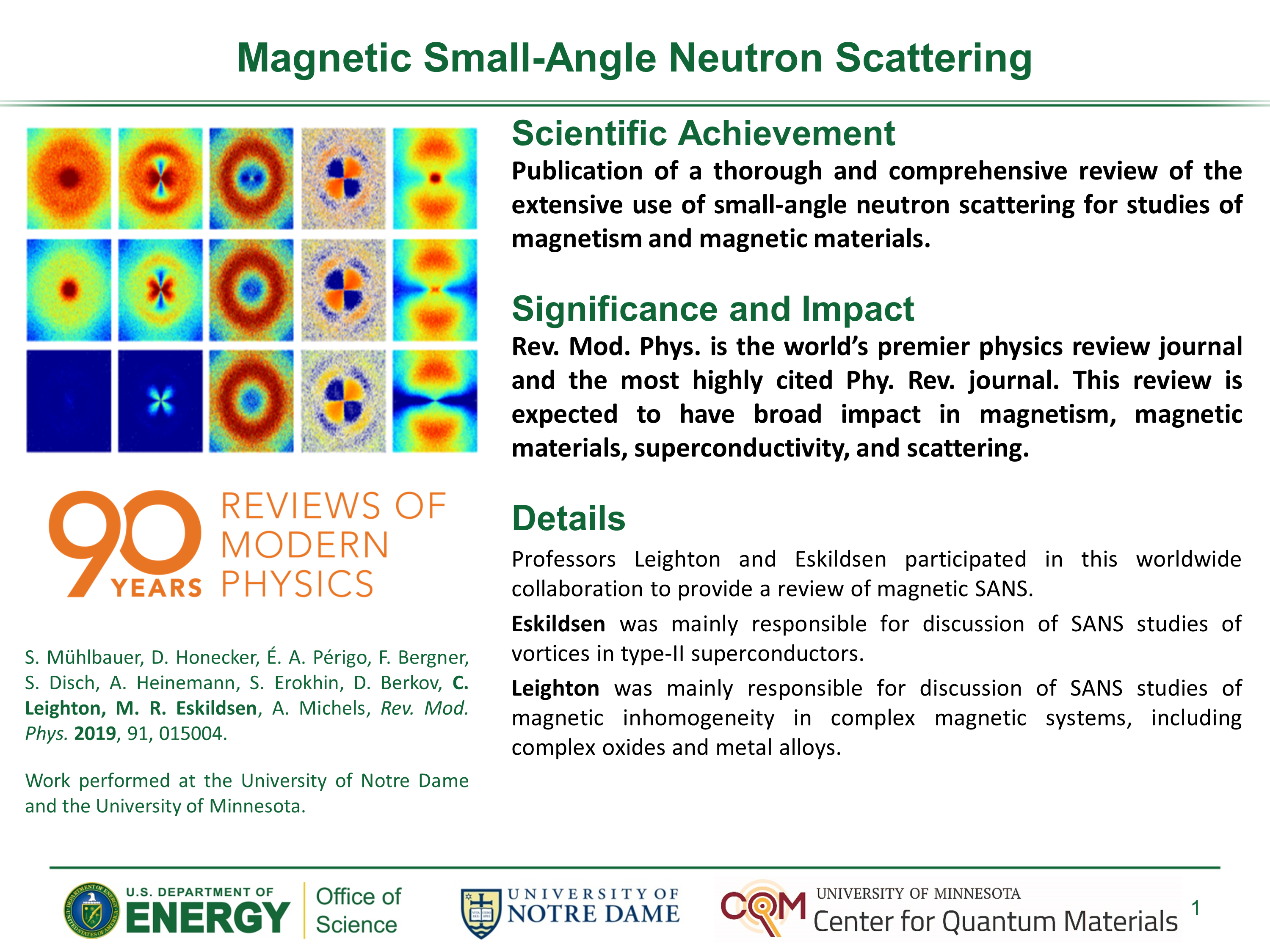
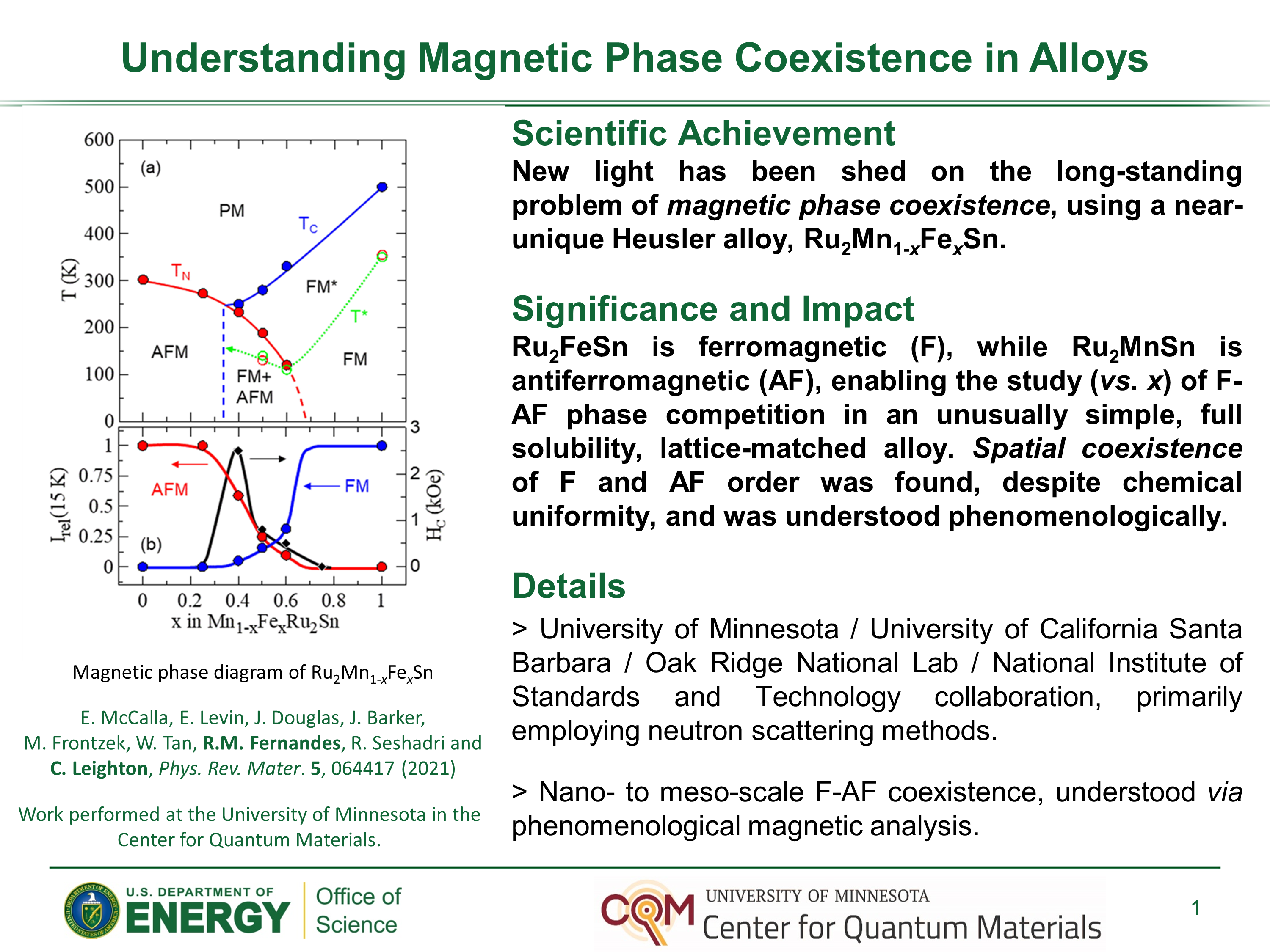
This work, which will shortly appear in Physical Review Materials, uses the new Heusler system Ru2Mn1-xFexSn to take a fresh look at the long-standing problem of F-AF magnetic phase competition in alloys. Ru2MnSn is AF, while Ru2FeSn is F, with full solubility in the Ru2Mn1-xFexSn system, no change in structure, and only extremely minor changes in lattice parameter. This is a very unusual situation, providing an ideal test-bed for this problem. In essence, we find at intermediate x that both F and AF order parameters develop freely, with no detectable impact on one another, and with no evidence of the alternative scenario of some distinct magnetic phase such as ferrimagnetism or canted AF. This is all observed via neutron diffraction and magnetic small-angle neutron scattering (SANS) measurements. The length scales were also measured with these techniques, demonstrating spatial coexistence of the F and AF order on nano- to meso-scales. Specific heat was used as a secondary probe, confirming this picture. Using phenomenological analysis, the key experimental observations were then put in the full context of prior work using disordered Heisenberg models, pinpointing the key role played by disorder, i.e., local compositional fluctuations, even in the absence of gross chemical phase separation. This work thus substantially advances the understanding of this classic effect, through the use of collaborative neutron scattering and complementary theory, applied to a new materials system. All work at the University of Minnesota was supported by the DOE CQM.

Mott insulators are materials that are expected to be metallic based on conventional band theory yet exhibit insulating behavior. One of the pioneering developments in condensed matter physics was an explanation for this behavior, put forth by N. F. Mott. In a crystal lattice with each site occupied by a single electron (half-filling), hopping of an electron from one site to the other is strongly disfavored by repulsive electron-electron Coulomb interactions, hence leading to an insulating behavior. Based on this theory, hole doping, which removes electrons from the system, frees up lattice sites for electrons to hop into, thus leading to metallicity. However, experiments on several transition metal oxides have revealed that the Mott-insulating state remains stable up to rather high hole concentrations. In this work, we study a prototypical Mott-insulator YTiO3, where the insulating state remains stable up to a surprisingly large 35% hole-doping level. Using X-ray absorption spectroscopy, which allows us to look at the element-wise electronic states, together with density-functional-theory (DFT) calculations, we find that the system phase separates into Mott-insulating regions without holes and metallic hole-rich regions with about 50% holes. Overall metallic behavior is observed only when the metallic regions form a connected percolative path. The findings are in qualitative agreement with recent theoretical work. Our results constitute the first spectroscopic evidence for hole-doping-induced separation of a material into hole-deficient and hole-rich regions, and they are likely to motivate future experimental and theoretical work on these and other correlated quantum materials.
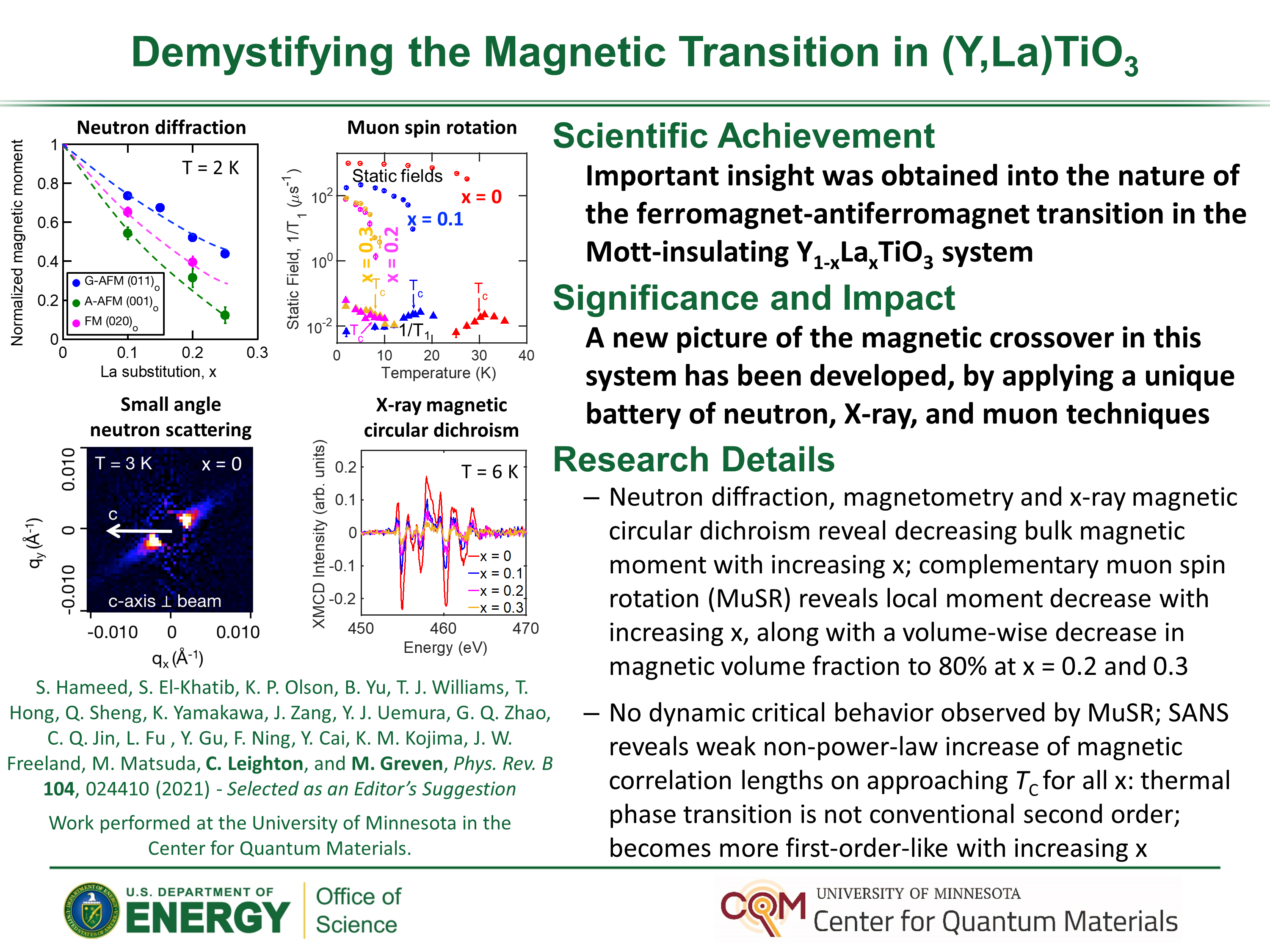
The rare-earth titanates (RTiO3) exhibit a distorted perovskite structure, which consist of TiO6 octahedra with a Ti-O-Ti bond angle of less than 180 degrees. The size of the R ion determines the Ti-O-Ti bond angle, which controls the magnetic superexchange interaction. Materials with a small R ion have a ferromagnetic ground state, whereas those with a large R ion have an antiferromagnetic ground state. Here we take the ferromagnet YTiO3 and the antiferromagnet LaTiO3 to form the solid solution system Y1-xLaxTiO3, with which we can continuously control the magnetic ground state with the La substitution level x. We were able to grow single crystals with x up to 0.3 (the system remains ferromagnetic in this La substitution range) and studied the magnetic ground state with five different techniques: Magnetometry, Neutron diffraction, Small Angle Neutron Scattering (SANS), X-ray Magnetic Circular Dichroism (XMCD) and Muon Spin Rotation (MuSR). We find a strong decrease in the ferromagnetic ordered moment with x, the decrease being ~ 60% at x = 0.2. However, the magnetic volume fraction, as determined from MuSR, decreases from 100% at x = 0 to only 80% at x = 0.2 and 0.3. This implies a strong reduction in the local moments in the system, likely associated with frustrated antiferromagnetic interactions due to La substitution. Surprisingly, SANS and MuSR reveal the absence of critical behavior near TC in all x. Specifically, SANS observed no power-law divergence of the correlation lengths, and MuSR observes no peak in the spin-lattice relaxation rate near TC. The results strongly point to a first-order nature for the thermal phase transitions.

This work, reported in Physical Review Materials recently, employed high pressure oxygen sputter deposition to substantially advance the understanding of the critical deposition-structure-property relations in La-doped BaSnO3 thin films, thus optimizing the mobility. The electron mobility at room temperature in sputtered films was thus increased from 30 to 96 cm2V-1s-1, setting a new record and bringing the field within reach of 100 cm2V-1s-1, and thus very close to the far better studied pulsed laser deposition (PLD) films. Advancing sputtered mobilities to the level of PLD and MBE-grown materials is vitally important given the massive role played by sputtering techniques in technology; this technique is highly amenable to industrial adoption. BaSnO3 is of high interest for oxide, transparent, and power electronic applications. In more detail, high pressure oxygen sputtering was combined with X-ray scattering, transmission electron microscopy, atomic force microscopy, and a plethora of electronic transport measurements, considering the influence of substrate, lattice mismatch, deposition temperature, deposition rate, deposition pressure, thickness, etc. Several fascinating trends were uncovered and rationalized, including a highly counterintuitive improvement in mobility with increasing lattice mismatch. The optimized mobility was achieved in buffered, annealed films, although very similar values are possible without a buffer layer (important in some cases), and without post-deposition annealing. It is highly likely that this study will now enable sputtered films to reach room temperature electron mobilities comparable to PLD-grown materials, which is remarkable given the relatively little work in this direction, and the relative simplicity and technological relevance of the growth process.
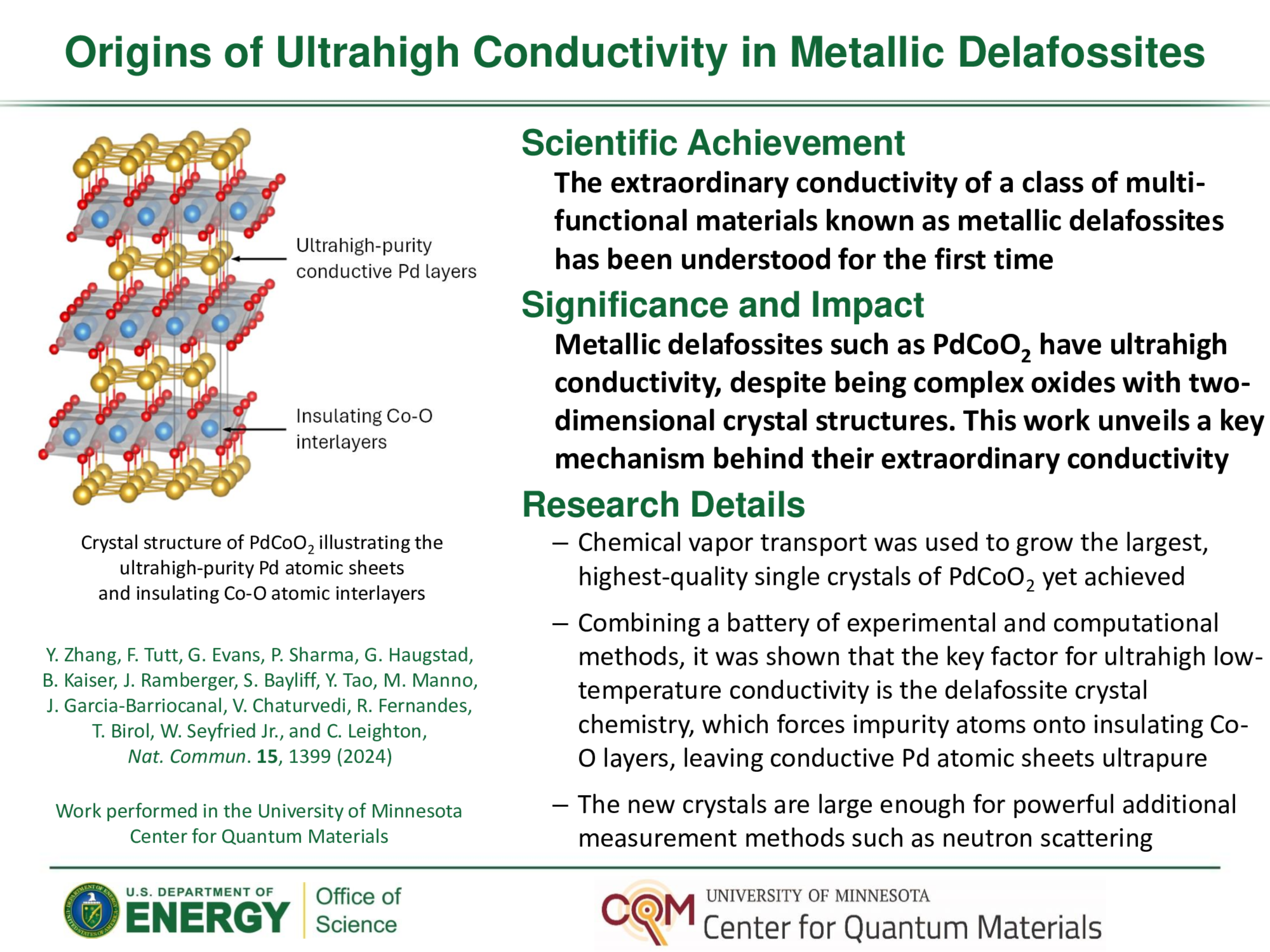
The metallic delafossites, exemplified by PdCoO2, have emerged recently as an extraordinary class of materials, having the highest conductivity among all oxides. Their room temperature conductivity exceeds that of Au, while their low-temperature electron mean-free-path reaches a staggering 20 microns, despite their complex oxidic nature and two-dimensional structure. It was previously unknown how this is possible. There is also growing interest in applications for these materials, in transparent conductors, electrocatalysis, ballistic transport devices, harsh-environment electronic devices, etc. This work first applied a new crystal growth method to these materials, using chemical vapor transport to achieve 500X gains in crystal size and the highest structural and electronic qualities yet reported. Nevertheless, the first detailed impurity analyses on such crystals revealed that they are not generally pure enough to sustain such extraordinary conductivities and mean-free-paths, contradicting property measurements. Through crystal chemical analyses, however, it was shown that the vast majority of impurities are forced to adopt the insulating Co-O atomic interlayers, leaving the conductive Pd atomic sheets ultrapure and ultraperfect. We dub this mechanism “sublattice purification”, explaining, for the first time, the origin of the ultrahigh low-temperature conductivity of these materials. In addition, our advance in crystal growth opens up many additional measurement techniques in this materials class, most notably the powerful methods of neutron scattering.
Funded by the Department of Energy under DE-SC0016371
